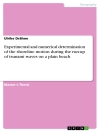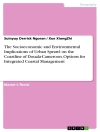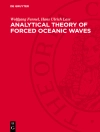This book collects the latest advances, innovations, and applications in the field of environmental science and sustainable development, which were presented by scholars and researchers at the 2021 6th Asia Conference on Environment and Sustainable Development, held in Phuket, Thailand, November 6–8, 2021. The book covers highly diverse topics, including environmental dynamics, global environmental change and ecosystems management, environmental restoration and ecological engineering, water treatment and reclamation, environmental sustainability, health and the environment, wastewater and sludge treatment, solid waste management, air pollution and control. The contributions, which were selected in a rigorous international peer-review process, highlight numerous exciting ideas that will spur novel research directions and foster multidisciplinary collaborations.
Jadual kandungan
– Evaluating the Potential of Vegetation to Capture Pollutants in Urban Environment.- Reference Levels for Heavy Metals in Soil in the City of Cerro de Pasco – Peru – 2020.- Urban Environmental Risk Spatial Pattern Assessment Supported by Remote Sensing and GIS — Shanghai, China.- A Review on RES Energy Transition-Climate Change Interaction Effects.- Socially Engaged Buddhism of Kalmykia: Land Degradation and the Ecological Initiatives of the Central Khurul.- Preliminary Concentration-Response Functions on the Relationship between Long-Term PM2.5 Exposure and Incidence and Prevalence of Depression Based on Systematic Review and a Meta-Analysis.- Global INDCs Gap, Dilemma and Innovative Path of Carbon Sink Increase.- Effect of Hedgerows on CO Diffusion from Vehicle Exhaust Emissions in Street Canyons.- Synthesis of Green Nano Composite Using Sugar Cane Waste for the Treatment of Cr ions from Waste Water.- Heavy Metal Water Pollution: Transport and Transformation, Impacts and Treatment Technologies.- The Removal Effect of Organic Pollutants by Different Fillers in Constructed Rapid Infiltration System.- Comparative Study on Nitrogen Removal Efficiency of Surface Water by Three New Combined Processes of Autotrophic Denitrification.- Development of a Composite Solid Desiccant Dehumidifier for Ventilation Air.- Applicability Analysis of Hydrological Models in the Middle and Upper Reaches of Yangtze River.- Analysis on the Response of Lake Level Changes: A Hybrid Stepwise-Cluster Factorial Approach.- Seepage Experiment on a Permeable Dam Formed by Debris Flow from River Tributaries.- Assessment of Climate Change Impacts on Streamflow – A Case Study of Naryn River Basin, Central Asia.- Joint-Risk Evaluation of Extreme Precipitation Using Copulas.- Optimal Allocation of Flood Control Capacity of Multiple Reservoir System.- Experimental Study for Optimizing of Low Impact Development Facilities in Taiwan.- Design of Green Infrastructure for the Revaluation of the Ventanilla-Peru Wetlands and the Protection of the Environment.- Effect of the Window Design Features on Natural Ventilation.- How to Make Green Building Certification & Rating Systems more Pandemic-Sustainable?.- Assessing Risk Factors in the Implementation of Green Building Projects: Empirical Research from Vietnam.- Environmental Affordances: A Practical Approach for Designing Child-Friendly Streets in High-Density Community.- Study on the Ecological Regeneration Strategy of Urban Industrial Sites—Taking Diamond Bay in Dalian as an Example.- Scenario Analysis of Annual Heating Energy Demand in North China from 2020 to 2050.- An Integrated Bi-level Optimization Model for Planning Water-Food-Energy Nexus System under Uncertainty.- Recovery of Eco-Friendly Spaces for Ecotourism and the Integration of Visitors in Morro de Calzada – Peru.- Planning Water-Food-Energy Nexus System towards Sustainable Development under Uncertainty.- Assessing Consumers’ Intentions towards Green Alternatives of Disposable Packaging: A Case Study in Beijing and Shanghai.- Comparative Evaluation of APTI of Plant Species at Two Different Sites near CCI-Rajban Cement Factory, Sirmaur.- Elemental Status of European Mole (T. europaea) in the Conditions of the Plast Region of the Chelyabinsk Oblast in Russian.- Effects of Crude Oil and Chemically Dispersed Crude Oil on the Antioxidant Response and Apoptosis in the Respiratory Tree of Sea Cucumber (Apostichopus japonicus).- Environmental Impact of Fluorine Pollution in Tursunzade Manufactured Biogeochemical Province (Tajikistan).- Analysis on Bird Communities Response to Different Urban Land-Cover and Land-Use Types in Greater Manchester.
Mengenai Pengarang
Keiji Ujikawa is a full professor in the Graduate School of International Social Sciences, Yokohama National University, Japan. He specializes in environmental economics, environmental policy studies, environmental valuation, and economic statistics. Professor Ujikawa’s research interests include indicators, decision making and impact assessment of sustainable development. He is also interested in economic, social, and environmental effects of renewable energy (energy conservation) expansion. In 2002, he received his Doctor of Philosophy in Economics from the Graduate School of Economics and Management, Tohoku University. In 2007, he was a visiting researcher in the Business School at Beijing Normal University, Beijing, China. He published several books and a large number of academic articles, and he served as the representative of research projects. In addition, he has trained many Master’s and Ph.D. students from abroad.
He is an editorial committee member of the Pan Pacific Association of Input–Output Studies (PAPAIOS). He is also a member of the Society for Environmental Economics and Policy Studies (SEEPS) and many other academic organizations.
Mikio Ishiwatari is a senior advisor on disaster management and water resources management at the Japan International Cooperation Agency, and a visiting professor at the Graduate School of Frontier Sciences, The University of Tokyo. He has been engaged in projects and research work on disaster risk reduction, climate change adaptation, and water issues. He led the formulation of the Japanese assistance policies of climate change adaptation and community-based disaster management.
At the World Bank he worked as a senior disaster risk management specialist and published Learning from Megadisaster: Lessons from the Great East Japan Earthquake. He worked in various positions at the Ministry of Land, Infrastructure, and Transport, Japan, for 17 years. He formulated and supervised national projects on flood risk management and highways in Iwami District as the director of the Hamada River and Road Office, and he was responsible for research and technology development as a senior deputy director for river technology and information. He also worked as an urban development specialist at the Asian Development Bank.
Dr. Ishiwatari was a member of the Committee on Building Resilience to Natural Disasters of the Japan Science Society, and he served as a member of the Advisory Council of Development Assistance in Climate Change Adaptation of the Ministry of Land Infrastructure, Transport and Tourism, Japan; the Steering Committee of Water and Climate Change of the Asia-Pacific Water Forum; and other committees of government organizations. He holds a Ph.D. in international studies and an M.Sc. in urban engineering from The University of Tokyo.
Eric D. van Hullebusch holds a Ph.D. in aquatic chemistry and microbiology, and he is a full professor in the biogeochemistry of engineered ecosystems at the Université de Paris and Institut de Physique du Globe de Paris (Paris, France). His main research interests include environmental technologies and biogeochemistry with special focus on 1) study of metals and metalloids biogeochemistry in engineered ecosystems, 2) biohydrometallurgy of secondary resource streams, and 3) soil bioremediation. Within these research areas, he has published more than 250 papers in peer-reviewed scientific journals and is a co-author of more than 25 book chapters.












